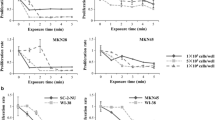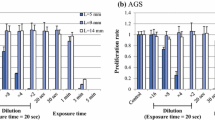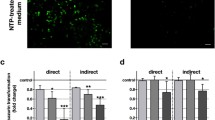Abstract
Background
The medical applications of nonequilibrium atmospheric pressure plasma in cancer therapy have attracted attention. We previously reported on the antitumor effect of plasma-activated medium. However, this approach requires plasma-activated liquids that are administrable to the human body. In this study, we produced plasma-activated lactated Ringer’s solution (PAL) and evaluated its antitumor effect and mechanism. Furthermore, we evaluated the effect of the intraperitoneal administration of PAL using a peritoneal dissemination mouse tumor model.
Methods
The antitumor effect of PAL on pancreatic cancer cell lines was evaluated using proliferation and apoptosis assays. In addition, cellular reactive oxygen species (ROS) generation was examined. The role of ROS was assessed using a proliferation assay with N-acetyl cysteine (NAC). An adhesion assay was performed to evaluate the effect of PAL on cell adhesion. Finally, pancreatic cancer cells stably expressing luciferase (AsPC-1/CMV-Luc) were injected intraperitoneally into mice, followed by intraperitoneal injection of PAL. Peritoneal dissemination was monitored using in vivo bioluminescent imaging.
Results
The antitumor effect of PAL was shown in all cell lines in vitro. The TUNEL assay showed that PAL induced apoptosis. ROS uptake was observed in PAL-treated cells, and the antitumor effect was inhibited by NAC. Cell adhesion also was suppressed by PAL. The intraperitoneal administration of PAL suppressed the formation of peritoneal nodules in vivo.
Conclusions
Our study demonstrated the antitumor effects of PAL in vitro and in vivo. Intraperitoneal administration of PAL may be a novel therapeutic option for peritoneal metastases.





Similar content being viewed by others
References
Malvezzi M, Carioli G, Bertuccio P, Boffetta P, Levi F, La Vecchia C, Negri E. European cancer mortality predictions for the year 2017, with focus on lung cancer. Ann Oncol. 2017;28:1117–23.
Siegel R, Ma J, Zou Z, Jemal A. Cancer statistics, 2014. CA Cancer J Clin. 2014;64:9–29.
Satoi S, Fujii T, Yanagimoto H, et al. Multicenter phase II study of intravenous and intraperitoneal paclitaxel with S-1 for pancreatic ductal adenocarcinoma patients with peritoneal metastasis. Ann Surg. 2017; 265:397–401.
Yamada S, Takeda S, Fujii T, et al. Clinical implications of peritoneal cytology in potentially resectable pancreatic cancer: positive peritoneal cytology may not confer an adverse prognosis. Ann Surg. 2007;246:254–8.
Fridman G, Friedman G, Gutsol A, Shekhter AB, Vasilets VN, Fridman A. Applied plasma medicine. Plasma Process Polym. 2008;5:503–33.
Keidar M, Walk R, Shashurin A, et al. Cold plasma selectivity and the possibility of a paradigm shift in cancer therapy. Br J Cancer. 2011;105:1295–301.
Brulle L, Vandamme M, Ries D, et al. Effects of a non thermal plasma treatment alone or in combination with gemcitabine in a MIA PaCa2-luc orthotopic pancreatic carcinoma model. PLoS One. 2012;7:e52653.
Huang J, Chen W, Li H, et al. Deactivation of A549 cancer cells in vitro by a dielectric barrier discharge plasma needle. J Appl Phys. 2011;109:053305.
Lupu AR, Georgescu N, Calugaru A, Cremer L, Szegli G, Kerek F. The effects of cold atmospheric plasma jets on B16 and COLO320 tumoral cells. Roum Arch Microbiol Immunol. 2009;68:136–44.
von Woedtke T, Reuter S, Masur K, Weltmann KD. Plasmas for medicine. Phys Rep. 2013;530:291–320.
Sensenig R, Kalghatgi S, Cerchar E, et al. Non-thermal plasma induces apoptosis in melanoma cells via production of intracellular reactive oxygen species. Ann Biomed Eng. 2011;39:674–87.
Tanaka H, Mizuno M, Ishikawa K, et al. Plasma-activated medium selectively kills glioblastoma brain tumor cells by down-regulating a survival signaling molecule, AKT kinase. Plasma Med. 2011;1:265–77.
Torii K, Yamada S, Nakamura K, et al. Effectiveness of plasma treatment on gastric cancer cells. Gastric Cancer. 2015;18:635–43.
Hattori N, Yamada S, Torii K, et al. Effectiveness of plasma treatment on pancreatic cancer cells. Int J Oncol. 2015;47:1655–62.
Takeda S, Yamada S, Hattori N, et al. Intraperitoneal administration of plasma-activated medium: proposal of a novel treatment option for peritoneal metastasis from gastric cancer. Ann Surg Oncol. 2017;24:1188–94.
Tanaka H, Nakamura K, Mizuno M, et al. Non-thermal atmospheric pressure plasma activates lactate in Ringer’s solution for anti-tumor effects. Sci Rep. 2016;6:36282.
Schlegel J, Köritzer J, Boxhammer V. Plasma in cancer treatment. Clin Plasma Med. 2013;1:2–7.
Utsumi F, Kajiyama H, Nakamura K, Tanaka H, Hori M, Kikkawa F. Selective cytotoxicity of indirect nonequilibrium atmospheric pressure plasma against ovarian clear-cell carcinoma. SpringerPlus. 2014;3:398.
Girard PM, Arbabian A, Fleury M, Bauville G, Puech V, Dutreix M, Sousa JS. Synergistic effect of H2O2 and NO2 in cell death induced by cold atmospheric He plasma. Sci Rep. 2016;6:29098.
Graves DB. The emerging role of reactive oxygen and nitrogen species in redox biology and some implications for plasma applications to medicine and biology. J Phys D Appl Phys. 2012;45:263001.
Jablonowski H, von Woedtke T. Research on plasma medicine-relevant plasma–liquid interaction: what happened in the past five years? Clin Plasma Med. 2015;3:42–52.
Bekeschus S, Kolata J, Winterbourn C, et al. Hydrogen peroxide: a central player in physical plasma-induced oxidative stress in human blood cells. Free Radic Res. 2014;48:542–9.
Yan D, Nourmohammadi N, Bian K, Murad F, Sherman JH, Keidar M. Stabilizing the cold plasma-stimulated medium by regulating medium’s composition. Sci Rep. 2016;6:26016.
Takai E, Kitamura T, Kuwabara J, et al. Chemical modification of amino acids by atmospheric-pressure cold plasma in aqueous solution. J Phys D Appl Phys. 2014;47:285403.
Kieft IE, Broers JL, Caubet-Hilloutou V, Slaaf DW, Ramaekers FC, Stoffels E. Electric discharge plasmas influence attachment of cultured CHO K1 cells. Bioelectromagnetics. 2004;25:362–8.
Haertel B, Wende K, von Woedtke T, Weltmann KD, Lindequist U. Non-thermal atmospheric-pressure plasma can influence cell adhesion molecules on HaCaT-keratinocytes. Exp Dermatol. 2011;20:282–4.
Shashurin A, Stepp MA, Hawley TS, et al. Influence of cold plasma atmospheric jet on surface integrin expression of living cells. Plasma Process Polym. 2010;7:294–300.
Sluiter N, de Cuba E, Kwakman R, Kazemier G, Meijer G, Te Velde EA. Adhesion molecules in peritoneal dissemination: function, prognostic relevance and therapeutic options. Clin Exp Metastasis. 2016;33:401–6.
Sawai H, Okada Y, Funahashi H, Matsuo Y, Takahashi H, Takeyama H, Manabe T. Interleukin-1alpha enhances the aggressive behavior of pancreatic cancer cells by regulating the alpha6beta1-integrin and urokinase plasminogen activator receptor expression. BMC Cell Biol. 2006;7:8.
Disclosure
There are no conflicts of interest or financial ties to disclose.
Author information
Authors and Affiliations
Corresponding author
Electronic supplementary material
Below is the link to the electronic supplementary material.
10434_2017_6239_MOESM1_ESM.pptx
Supplementary Fig. 1 Adhesion assay. A total of 2.5 × 105 floating cells were exposed to PAL, Lactec, or RPMI-1640 for 10 min. After PAL treatment, Lactec or RPMI-1640 was replaced with RPMI-1640, and the cells were seeded on a 96-well collagen-coated plate. One hour later, unattached cells were removed, and the number of adherent cells was estimated using an MTS assay. Assays were performed in triplicate (PPTX 83 kb)
Rights and permissions
About this article
Cite this article
Sato, Y., Yamada, S., Takeda, S. et al. Effect of Plasma-Activated Lactated Ringer’s Solution on Pancreatic Cancer Cells In Vitro and In Vivo. Ann Surg Oncol 25, 299–307 (2018). https://doi.org/10.1245/s10434-017-6239-y
Received:
Published:
Issue Date:
DOI: https://doi.org/10.1245/s10434-017-6239-y




